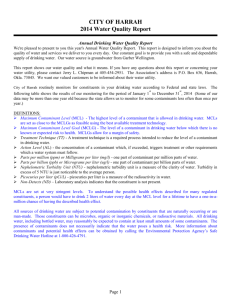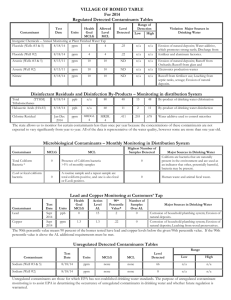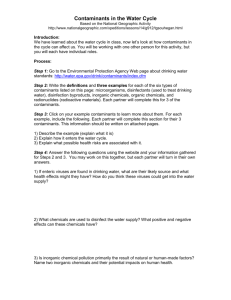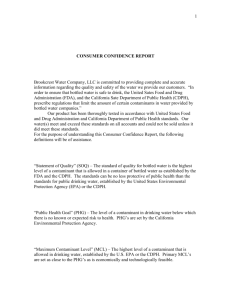2013 Annual Drinking Water Quality Report Charlotte-Mecklenburg Utility Department
advertisement
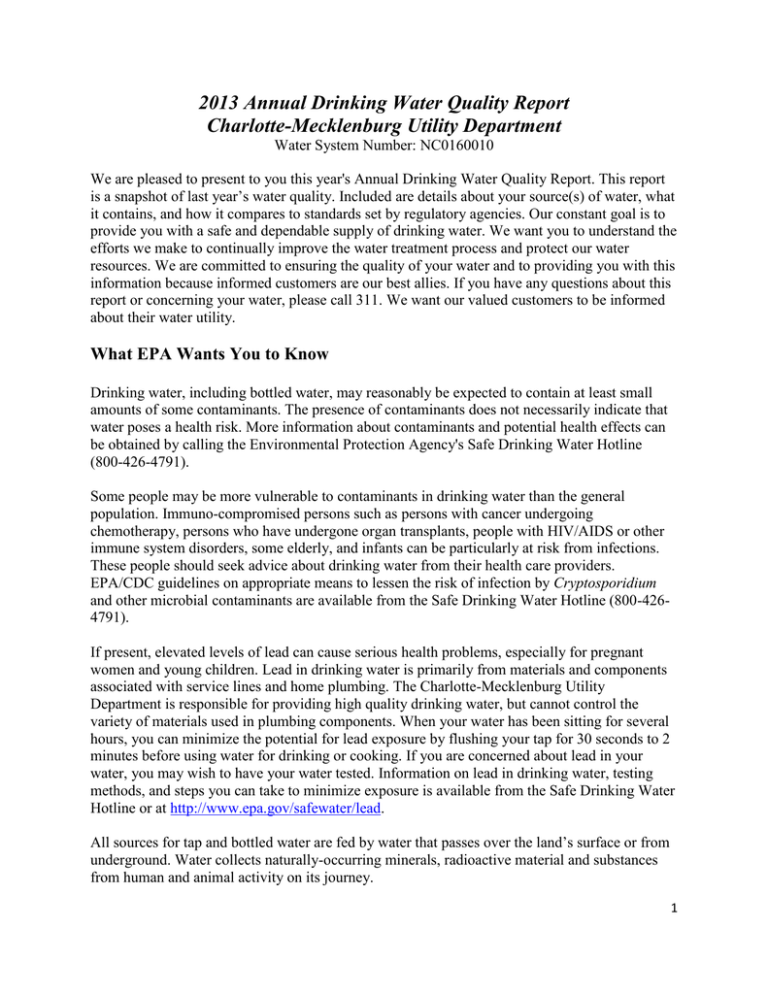
2013 Annual Drinking Water Quality Report Charlotte-Mecklenburg Utility Department Water System Number: NC0160010 We are pleased to present to you this year's Annual Drinking Water Quality Report. This report is a snapshot of last year’s water quality. Included are details about your source(s) of water, what it contains, and how it compares to standards set by regulatory agencies. Our constant goal is to provide you with a safe and dependable supply of drinking water. We want you to understand the efforts we make to continually improve the water treatment process and protect our water resources. We are committed to ensuring the quality of your water and to providing you with this information because informed customers are our best allies. If you have any questions about this report or concerning your water, please call 311. We want our valued customers to be informed about their water utility. What EPA Wants You to Know Drinking water, including bottled water, may reasonably be expected to contain at least small amounts of some contaminants. The presence of contaminants does not necessarily indicate that water poses a health risk. More information about contaminants and potential health effects can be obtained by calling the Environmental Protection Agency's Safe Drinking Water Hotline (800-426-4791). Some people may be more vulnerable to contaminants in drinking water than the general population. Immuno-compromised persons such as persons with cancer undergoing chemotherapy, persons who have undergone organ transplants, people with HIV/AIDS or other immune system disorders, some elderly, and infants can be particularly at risk from infections. These people should seek advice about drinking water from their health care providers. EPA/CDC guidelines on appropriate means to lessen the risk of infection by Cryptosporidium and other microbial contaminants are available from the Safe Drinking Water Hotline (800-4264791). If present, elevated levels of lead can cause serious health problems, especially for pregnant women and young children. Lead in drinking water is primarily from materials and components associated with service lines and home plumbing. The Charlotte-Mecklenburg Utility Department is responsible for providing high quality drinking water, but cannot control the variety of materials used in plumbing components. When your water has been sitting for several hours, you can minimize the potential for lead exposure by flushing your tap for 30 seconds to 2 minutes before using water for drinking or cooking. If you are concerned about lead in your water, you may wish to have your water tested. Information on lead in drinking water, testing methods, and steps you can take to minimize exposure is available from the Safe Drinking Water Hotline or at http://www.epa.gov/safewater/lead. All sources for tap and bottled water are fed by water that passes over the land’s surface or from underground. Water collects naturally-occurring minerals, radioactive material and substances from human and animal activity on its journey. 1 Impurities that may be present in untreated water include: Microbial - viruses and bacteria from human, agricultural or wildlife sources. Inorganic - salts and metals that are naturally-occurring or from urban runoff, industrial or domestic wastewater discharges, mining or farming. Pesticides and herbicides - may come from agricultural runoff or residential use. Organic chemicals - may come from industrial or domestic processes, oil and gas production, runoff and septic systems. Radioactive materials - can be naturally occurring or from mining or human activities. The EPA regulates the amount of certain substances in your tap water. The Food and Drug Administration establishes limits for contaminants in bottled water also to protect public health. When You Turn on Your Tap, Consider the Source Mountain Island Lake and Lake Norman supply our treatment plants with high quality water for your home, business or school. These surface waters are part of the Catawba River Basin, which provides water for more than 1.5 million people in our growing region. CMUD operates three water treatment plants, and they collectively clean an average of 100 million gallons a day for more than 800,000 people in Mecklenburg County. Our Treatment Process Long before you step in the shower or turn on the tap, CMUD employees have managed numerous processes to protect our drinking water and those who use it. First we pump the water from Mountain Island Lake and Lake Norman to one of the three water treatment plants Franklin, Vest or Dukes. We add aluminum sulfate (alum) in the rapid mix phase to cause dirt particles to clump together, where they are removed through settling. The water then flows through filters that trap even smaller particles. We add chlorine to prevent bacterial growth and fluoride to promote dental health. We also use lime to adjust the water’s pH and prevent pipe corrosion. We then pump the water to homes, businesses and storage tanks through 4,200 miles of water pipes. Source Water Assessment Program (SWAP) Results The North Carolina Department of Environment and Natural Resources (DENR), Public Water Supply (PWS) Section, Source Water Assessment Program (SWAP) conducted assessments for all drinking water sources across North Carolina. The purpose of the assessments was to determine the susceptibility of each drinking water source (well or surface water intake) to Potential Contaminant Sources (PCSs). The results of the assessment are available in SWAP Assessment Reports that include maps, background information and a relative susceptibility rating of Higher, Moderate or Lower. 2 The relative susceptibility rating of each source for CMUD was determined by combining the contaminant rating (number and location of PCSs within the assessment area) and the inherent vulnerability rating (i.e., characteristics or existing conditions of the well or watershed and its delineated assessment area). The assessment findings are summarized in the table below: Susceptibility of Sources to Potential Contaminant Sources (PCSs) Source Inherent Vulnerability Rating Contaminant Rating Susceptibility Rating Date Mt. Island Lake/Catawba River Moderate Moderate Moderate March 2010 Lake Norman Higher Higher Higher March 2010 The complete SWAP Assessment report for CMUD may be viewed on the Web at: www.ncwater.org/pws/swap. Note that because SWAP results and reports are periodically updated by the PWS Section, the results available on this web site may differ from the results that were available at the time this CCR was prepared. If you are unable to access your SWAP report on the web, you may mail a written request for a printed copy to: Source Water Assessment Program – Report Request, 1634 Mail Service Center, Raleigh, NC 27699-1634, or email requests to swap@ncdenr.gov. Please indicate your system name, number, and provide your name, mailing address and phone number. If you have any questions about the SWAP report please contact the Source Water Assessment staff by phone at 919-707-9098. It is important to understand that a susceptibility rating of “higher” does not imply poor water quality, only the system’s potential to become contaminated by PCSs in the assessment area. Water Quality Data Tables of Detected Contaminants We routinely monitor for over 150 contaminants in your drinking water according to Federal and State laws. The table below lists all the drinking water contaminants that we detected in the last round of sampling for the particular contaminant group. The presence of contaminants does not necessarily indicate that water poses a health risk. Unless otherwise noted, the data presented in this table is from testing done January 1 through December 31, 2013. The EPA and the State allow us to monitor for certain contaminants less than once per year because the concentrations of these contaminants are not expected to vary significantly from year to year. Some of the data, though representative of the water quality, is more than one year old. 3 Important Drinking Water Definitions: Not-Applicable (N/A) – Information not applicable/not required for that particular water system or for that particular rule. Non-Detects (ND) - Laboratory analysis indicates that the contaminant is not present at the level of detection set for the particular methodology used. Parts per million (ppm) or Milligrams per liter (mg/L) - One part per million corresponds to one minute in two years or a single penny in $10,000. Parts per billion (ppb) or Micrograms per liter (ug/L) - One part per billion corresponds to one minute in 2,000 years, or a single penny in $10,000,000. Parts per trillion (ppt) or Nanograms per liter (nanograms/L) - One part per trillion corresponds to one minute in 2,000,000 years, or a single penny in $10,000,000,000. Parts per quadrillion (ppq) or Picograms per liter (picograms/L) - One part per quadrillion corresponds to one minute in 2,000,000,000 years or one penny in $10,000,000,000,000. Picocuries per liter (pCi/L) - Picocuries per liter is a measure of the radioactivity in water. Million Fibers per Liter (MFL) - Million fibers per liter is a measure of the presence of asbestos fibers that are longer than 10 micrometers. Nephelometric Turbidity Unit (NTU) - Nephelometric turbidity unit is a measure of the clarity of water. Turbidity in excess of 5 NTU is just noticeable to the average person. Action Level (AL) - The concentration of a contaminant which, if exceeded, triggers treatment or other requirements which a water system must follow. Treatment Technique (TT) - A required process intended to reduce the level of a contaminant in drinking water. Maximum Residual Disinfection Level Goal (MRDLG) – The level of a drinking water disinfectant below which there is no known or expected risk to health. MRDLGs do not reflect the benefits of the use of disinfectants to control microbial contaminants. Maximum Residual Disinfection Level (MRDL) – The highest level of a disinfectant allowed in drinking water. There is convincing evidence that addition of a disinfectant is necessary for control of microbial contaminants. Maximum Contaminant Level (MCL) - The highest level of a contaminant that is allowed in drinking water. MCLs are set as close to the MCLGs as feasible using the best available treatment technology. Maximum Contaminant Level Goal (MCLG) - The level of a contaminant in drinking water below which there is no known or expected risk to health. MCLGs allow for a margin of safety. RAA – Running Annual Average 4 Tables of Detected Contaminants Microbiological Contaminants in the Distribution System Contaminant (units) MCL Violation Y/N Your Water MCLG MCL Likely Source of Contaminatio n No 0.19% monthly average 0.66% highest monthly average 0 No more than 5% of monthly samples are positive Naturally present in the environment 0 0 (Note: The MCL is exceeded if a routine sample and repeat sample are total coliform positive, and one is also fecal coliform or E. coli positive) Human and animal fecal waste and naturally present in the environment. Total Coliform Bacteria (presence or absence) Fecal Coliform or E. coli (presence or absence) 0 positive sample No E.coli - Fecal coliforms and E.coli are bacteria whose presence indicates that the water may be contaminated with human or animal wastes. Microbes in these wastes can cause short-term effects, such as diarrhea, cramps, nausea, headaches, or other symptoms. They may pose a special health risk for infants, young children, some of the elderly, and people with severelycompromised immune systems. Turbidity* Contaminant (units) Turbidity (NTU) Highest single turbidity measurement Franklin Vest Dukes Turbidity (NTU) Lowest monthly percentage (%) of samples meeting turbidity limits Treatment Technique (TT) Violation Y/N Your Water Treatment Technique (TT) Violation if: Likely Source of Contamination .1 No .1 Turbidity > 1 NTU .1 100% No 100% 100% Soil runoff Less than 95% of monthly turbidity measurements are < 0.3 NTU 5 Franklin Vest Dukes * Turbidity is a measure of the cloudiness of the water. We monitor it because it is a good indicator of the effectiveness of our filtration system. The turbidity rule requires that 95% or more of the monthly samples must be less than or equal to 0.3 NTU. Inorganic Contaminants Contaminant (units) Fluoride (ppm) Franklin Vest Dukes Sample Date 2013 MCL Violati on Y/N Your Water No No No Range Low High MCLG .69 .69 .69 MCL Likely Source of Contamination 4 Erosion of natural deposits; water additive which promotes strong teeth; discharge from fertilizer and aluminum factories 4 Lead and Copper Contaminants Contaminant (units) Copper (ppm) (90th percentile) Lead (ppb) (90th percentile) Sample Date Your Water # of sites found above the AL MCLG AL 2013 None detected at 90th percentile N/A 1.3 AL=1.3 2013 7 ppb detected at 90th percentile 3 0 AL=15 Likely Source of Contamination Corrosion of household plumbing systems; erosion of natural deposits Corrosion of household plumbing systems, erosion of natural deposits 6 Total Organic Carbon (TOC) Contaminant (units) Total Organic Carbon (removal ratio) (TOC)TREATED Franklin Vest Dukes TT Violati on Y/N Your Water (RAA Remova l Ratio) MCLG TT Likely Source of Contamination Complia nce Method (Step 1 or ACC#__) Treated Water < 2.00 TT Naturally present in the environment ACC#2 1.011.64 1.34 No Range Monthly Removal Ratio Low High 0.921.07 0.92 1.19 0.921.45 Disinfectants and Disinfections Byproducts Contaminants Contaminant (units) THM (ppb) [Total Trihalometh anes] HAA5 (ppb) [Total Haloacetic Acids] Chlorine (ppm) Franklin Vest Dukes MCL/MR DL Violation Y/N Your Water RAA (Stage 1) No Range Low High MCLG MCL Likely Source of Contamination 59.7 N/A 80 By-product of drinking water chlorination No 17.3 N/A 60 By-product of drinking water disinfection No 1.30 1.28 1.20 MRDLG =4 MRDL =4 Water additive used to control microbes For THM: Some people who drink water containing trihalomethanes in excess of the MCL over many years may experience problems with their liver, kidneys, or central nervous systems, and may have an increased risk of getting cancer. 7 For HAA5: Some people who drink water containing haloacetic acids in excess of the MCL over many years may have an increased risk of getting cancer. Cryptosporidium Our system monitored for Cryptosporidium and found levels of 0 oocysts. Cryptosporidium is a microbial pathogen found in surface water throughout the U.S. Although filtration removes Cryptosporidium, the most commonly-used filtration methods cannot guarantee 100 percent removal. Our monitoring indicates the presence of these organisms in our source water and/or finished water. Current test methods do not allow us to determine if the organisms are dead or if they are capable of causing disease. Ingestion of Cryptosporidium may cause cryptosporidiosis, an abdominal infection. Symptoms of infection include nausea, diarrhea, and abdominal cramps. Most healthy individuals can overcome the disease within a few weeks. However, immuno-compromised people, infants and small children, and the elderly are at greater risk of developing life-threatening illness. We encourage immuno-compromised individuals to consult their doctor regarding appropriate precautions to take to avoid infection. Cryptosporidium must be ingested to cause disease, and it may be spread through means other than drinking water. Unregulated Contaminate Monitoring Name Reported Level Range Low High Strontium (ppb) Franklin 29.4 29.4 29.4 Vest 28.6 28.6 28.6 Dukes 30.1 30.1 30.1 Distribution System 29.8 29.8 29.8 Vanadium (ppb) Franklin 0.67 0.67 0.67 Vest 0.55 0.55 0.55 Dukes 0.60 0.60 0.60 Distribution System 0.68 0.68 0.68 Total Chromium (ppb) Distribution System 0.30 0.30 0.30 Chromium-6 (ppb) Distribution 0.073 0.073 0.073 * Unregulated contaminants monitoring helps EPA to determine where certain contaminants occur and whether it needs to regulate those contaminants. 8
